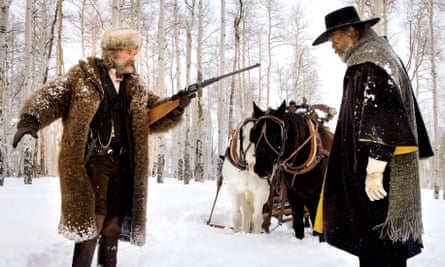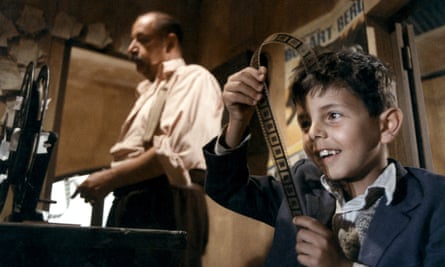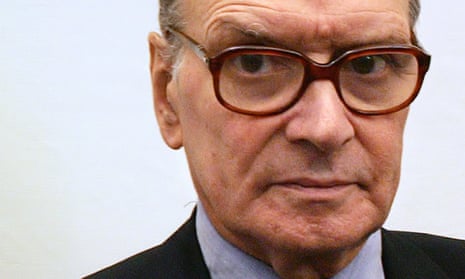In the extended title sequence of Sergio Leone’s epic 1968 western Once Upon a Time in the West, three vengeful-looking gunslingers await the arrival of the next train at the remote Cattle Corner Station. Not a word is shared between them. Instead, caught in vivid closeup like the lines ingrained on the weathered skin of their faces, it’s the sounds that tell a story: chalk screeches across a blackboard; water drips on to the brim of a hat and, in the dead stillness of the desert outside, a windpump gently squeaks. Even before knuckles are cracked, pistols are cocked and the man they’ve been waiting to kill announces his arrival with three mournful notes on a harmonica, it’s clear that things are about to turn ugly.
This month, that haunting harmonica is back, as Ennio Morricone celebrates 60 years in music with a concert tour of his film scores and a new album of his best-known themes. Yet like so much of Morricone’s music, the melancholic motif – whether inhabiting the dreamy soundscapes of the Orb’s “Little Fluffy Clouds” or Bruce Springsteen’s cowboy epic “Outlaw Pete” – now breathes with a life of its own. “It’s very gratifying that people are enjoying my music even though they don’t see it accompanied by scenes on film,” says Morricone, when we meet at his apartment in Rome. “Usually nobody thinks about the film composer – a movie could be silent; it could have music or not – whereas in concerts it’s different because the audience is there to listen to my music alone.”

Having just turned 88, and with around 500 soundtracks to his name, Morricone is one of cinema’s most prolific and stylistically diverse composers. On tour, as on disc, he conducts the baroque-styled choruses and lyrical oboe theme of The Mission alongside the paired down coyote-inspired howls of The Good, The Bad and the Ugly and the tenderly sentimental piano and string motifs of “Nuovo”, written for Giuseppe Tornatore’s Cinema Paradiso. The disc also includes themes for Quentin Tarantino’s high-tension western The Hateful Eight, which won Morricone an Academy award earlier this year. It was his first for an original score following five previous nominations, but he laughs when I suggest he take his tour to the US. “I don’t feel like flying and going all the way to America,” he says. “I didn’t even want to go and pick up the Oscar. The producer and the director asked me to please go.” He had to cancel three concerts earlier this year due to back problems, but throws open his arms in a broad show of generosity. “OK, I would go to America if they pay me loads of money.”
It’s from Rome that Morricone has made his name as one of Hollywood’s top-earning score writers, and it was here that he found his feet as a composer. He grew up in the Trastevere district, and began composing at the age of six, copying down works, such as Weber’s Der Freischütz overture, that he’d heard on the radio. His father, an accomplished trumpeter, supported the family by performing in local jazz clubs and on film soundtracks, and Ennio would dutifully follow in his footsteps: at the age of 10, he entered the Accademia Nazionale di Santa Cecilia to study trumpet, later also studying composition. At night he would play the clubs as a jazz trumpeter, stepping in for his father when he was ill.
Those war years were decisive for Morricone, as he discovered how light music could bring happiness during bleak times. In the late 1950s and early 60s he arranged hundreds of songs, and it was the whipcracks, bells and galloping rhythms of his arrangement of California-born folk singer Peter Tevis’s hit single “Pastures of Plenty” that impressed his former elementary-school classmate Leone when they reunited to discuss their first film together, A Fistful of Dollars.
Morricone prefers not to talk about his Leone projects, and has often pointed out that during the heyday of his western-scoring, between 1963 and 1980, a mere 35 of his 300 films were about cowboys. But it was their collaborations, and in particular the Dollars trilogy – A Fistful of Dollars, For a Few Dollars More and The Good, the Bad and the Ugly – that established his reputation and allowed him to pursue other projects. Rather than writing music to fit Leone’s footage, Morricone would start composing before filming began, with the director using the music on set to get his characters into the mood of the film. His scores build in three stages, from earthy percussion and humble folkish instruments – such as harmonica, panpipes or the Jew’s harp and whistles of For a Few Dollars More – to rock-influenced electronic guitars to orchestrations, featuring trumpets for the final showdowns, and expansive strings and chorus that perfectly match the epic journeys and widescreen compositions of Leone’s films. Instrumental colour is key. Conveying a distinct sense of character and place, these ramped-up themes deliver us into the world of the Old American West, where Clint Eastwood’s “Man with No Name” – a man so quick on the draw he’ll put his order in with the local coffin maker on his way into town, and add to it, after the shootout, on his way out – loom both heroically and absurdly larger than life. But the reason his tunes have lasted so well, says Morricone, is that the musical ideas are complete in themselves: “I learned by observing the use of Mozart and Bach and Mahler in movies. I said, ‘This is solid, it has integrity; I want to do something similar.’ That is why I started writing my music before the film was shot.”

The opening 13 minutes of Once Upon a Time are a playful reminder of how Morricone was grounded in experimental music, in particular the philosophy of John Cage. A member of the avant-garde ensemble Nuova Consonanza, Morricone was a firm advocate of challenging the boundaries between noise and music, and of the tone-row techniques of the Second Viennese School – his early compositions are atonal and complex. In all, he has written more than 100 concert works, often taking time out of his film schedule to focus on what he calls “the highest ideals of composition”; but still, he says, only 5% of his output is music that he aspires to write. “I’m not turning my back on film music; I’m not saying that I reject it,” he explains. “What I mean is that 95% of my music was written for the public at large, because a movie has to be understood by ordinary people who don’t necessarily understand complex music.” The 5% that does meet his ideals, he says, is “difficult music that I’ve experimented with, that I was really into but that I was strongly advised to leave behind. I had to leave it because it was too difficult. That doesn’t mean that 95% of my music is inane or trivial … it’s music catering to simple needs.”
It’s easy to imagine that cocooned in the silky strings of his early 80s charts hit Chi Mai is a classical composer just wriggling to get out. On film, he will often pay homage to classical repertoire, reinterpreting themes with a Stravinsky-like ease – augmenting Beethoven’s Für Elise melody in The Big Gundown, for example, to create the suspenseful motif that Tarantino would borrow for the opening scene of Inglorious Basterds. But Morricone’s relationship with the classical music tradition goes much deeper than style. When asked whether he arranges his works for concert performance, he says that his choice of instruments is integral to the themes he writes, so they are the same live as when you hear them on film: “When Beethoven wrote a symphony, that was that,” he says. “He didn’t adapt it to the theatre in which it was performed. If it was not appropriate, then he wouldn’t perform it there.”
As with Bernard Herrmann, who had aspirations to be taken seriously in the concert hall but would be forever thought of as Alfred Hitchcock’s composer, Morricone has formed close long-term relationships with directors who respect his vision. He has scored all of Tornatore’s films over the last three decades – including his forthcoming Jeremy Irons and Olga Kurylenko romance, Correspondence – and enjoyed a long and fruitful collaboration with Pier Paolo Pasolini, who showed him the power of using classical works on screen. Meanwhile, Morricone’s darker atonal sounds have found a natural home in the horror films of Dario Argento, and his more complex ideas continue to resurface – most recently his music for John Carpenter’s 1982 The Thing re-emerged in Tarantino’s Hateful Eight. “I haven’t had a problem with working in a risk-averse industry,” he says. “I always felt free and obviously directors call me because they hold me in the highest esteem.”

Perhaps that’s why, six decades on, Morricone seems to harbour none of the resentments or frustrations that his early ambitions to become an avant-garde composer might have left him with. Yes, he has made decisions he regrets, such as turning down Eastwood’s initial requests to work with him when the actor turned his hand to directing; and of the 500 films not all could be great (Michael Anderson’s post-Jaws film Orca, for example, always seemed destined to sink). But he has reached out to more listeners than most. When asked whether he would rather his new disc had been of his concert hall works, instead of music catering to “simple needs”, he laughs and excuses himself from the room. “I’ll give you one CD of mine,” he says, returning with a recording of his works written for children’s choir. “I produce and pay for the CDs that nobody will buy.” One day, he hopes, we’ll begin mining that 5%.

Comments (…)
Sign in or create your Guardian account to join the discussion